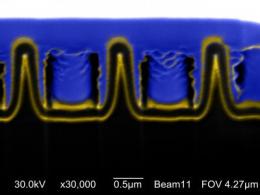Is 3-D Vision Bad for You? (09/06/2010)
Two-dimensional entertainment is so 2009.
With Sony’s release of the 3-D upgrade for PlayStation 3, the upcoming 3-D Nintendo DS, at least two 3-D television channels on the horizon, and the box office success of a little flick called Avatar, the consensus is clear: The future of entertainment is 3-D.
But while moviegoers have flocked to recent 3-D offerings, film fans also have had mixed reviews about their experien ces, with some reporting headaches, nausea, vision problems and motion sickness. And with 3-D leaping to the small screen, clinical researchers and tech experts want to know whether the special effect might damage eyes in the process.
ces, with some reporting headaches, nausea, vision problems and motion sickness. And with 3-D leaping to the small screen, clinical researchers and tech experts want to know whether the special effect might damage eyes in the process.
Beam Me Up, Scotty! Scientists Teleport Info 10 Miles (09/06/2010)
 We may never be able to teleport ourselves "Star Trek"-style, but scientists managed to transmit information a record distance using entangled photons.
We may never be able to teleport ourselves "Star Trek"-style, but scientists managed to transmit information a record distance using entangled photons.
Scotty won't beam anybody anywhere anytime soon, but a new report by Chinese scientists shows that it is possible to transmit information over long distances using quantum entanglement. The research, published in the current issue of the journal Nature Photonics, could lead to faster and smaller quantum-based computers and unbreakable, encrypted communication across the world.
Underwater Plumes of Oil Confirmed (08/06/2010)

Experts are starting to put together a three-dimensional view of the oil spill -- and what they're finding is more bad news.
Scientists have confirmed the spread of oil from the massive
Experts have completed a scientific analysis of the oil, the head of the National Oceanic and Atmospheric Administration, Jane Lubchenco, told a press conference.
Project focuses on physical stresses caused by multi-touch electronic devices (08/06/2010)
 Kanav Kahol, an assistant professor in ASU's Biomedical Informatics Department, is leading team of researchers in a project to measure the amount of strain on the hands and wrist of individuals who use multi-touch electronic devices, like Apple's iPad. They will use cyber gloves to measure the kinematic features produced while interacting with multi-touch systems. Credit: ASU photo by Scott Stuk
Kanav Kahol, an assistant professor in ASU's Biomedical Informatics Department, is leading team of researchers in a project to measure the amount of strain on the hands and wrist of individuals who use multi-touch electronic devices, like Apple's iPad. They will use cyber gloves to measure the kinematic features produced while interacting with multi-touch systems. Credit: ASU photo by Scott Stuk
'Nanocoax' solves solar cell 'thick and thin' dilemma (08/06/2010)
 Boston
Boston
First Human Infected with a Computer Virus (30/05/2010)
 As if humans didn't have enough viruses to worry about, one British researcher has successfully infected himself with a computer virus.
As if humans didn't have enough viruses to worry about, one British researcher has successfully infected himself with a computer virus.
Mark Gasson, senior research fellow at the University of Reading, was able to infect a tiny, radio frequency identification (RFID) chip with a virus before he placed it under the skin on his hand. He uses that chip to activate his cell phone, as well as open secure doors.
Thanks to the computer chip, his cell phone knows when he's using it, and when someone else is trying to operate the device. If someone else tries to use his phone (after, say, stealing it), that person is not able to use it. Only Gasson can.
Artificial life? Synthetic genes 'boot up' cell (25/05/2010)
 Scientists working to make a synthetic life form reported a major step forward Thursday, saying they had created an artificial genome and used it to bring a hollowed-out bacterium back to life.
Scientists working to make a synthetic life form reported a major step forward Thursday, saying they had created an artificial genome and used it to bring a hollowed-out bacterium back to life.
Researchers predict new computer security threat for wireless networks: Typhoid adware (22/05/2010)
 There's a potential threat lurking in your internet café, say University of Calgary computer science researchers. It's called Typhoid adware and works in similar fashion to Typhoid Mary, the first identified healthy carrier of typhoid fever who spread the disease to dozens of people in the New York area in the early 1900s.
There's a potential threat lurking in your internet café, say University of Calgary computer science researchers. It's called Typhoid adware and works in similar fashion to Typhoid Mary, the first identified healthy carrier of typhoid fever who spread the disease to dozens of people in the New York area in the early 1900s.
Quantum Move Toward Next Generation Computing (16/05/2010)
 Physicists at McGill University have developed a system for measuring the energy involved in adding electrons to semi-conductor nanocrystals, also known as quantum dots -- a technology that may revolutionize computing and other areas of science.
Physicists at McGill University have developed a system for measuring the energy involved in adding electrons to semi-conductor nanocrystals, also known as quantum dots -- a technology that may revolutionize computing and other areas of science.
Students win big at Intel ISEF 2010 (14/05/2010)
 Quantum dots, quantum computing and computing algorithm take top prizes at global high school science competition
Quantum dots, quantum computing and computing algorithm take top prizes at global high school science competition









